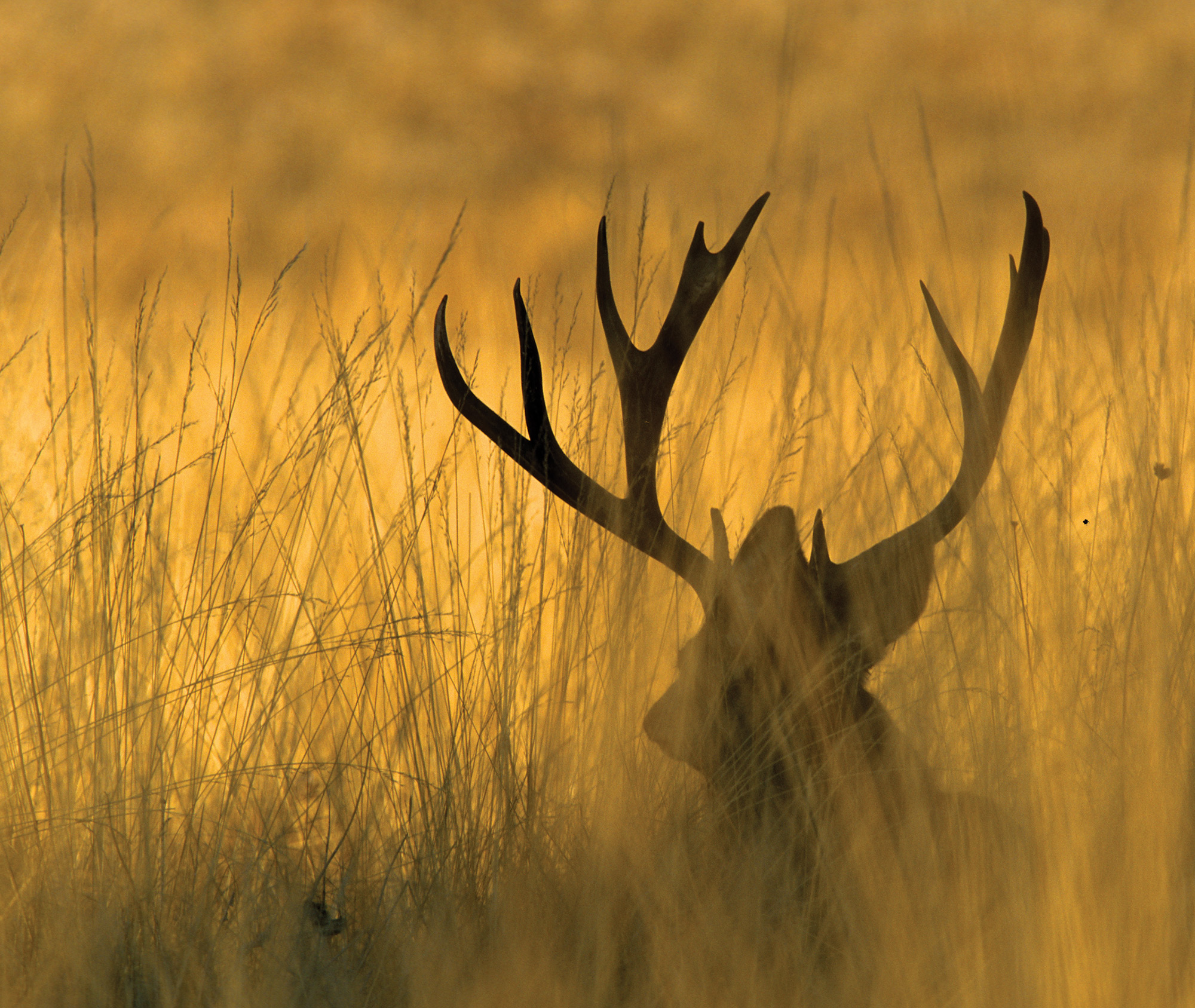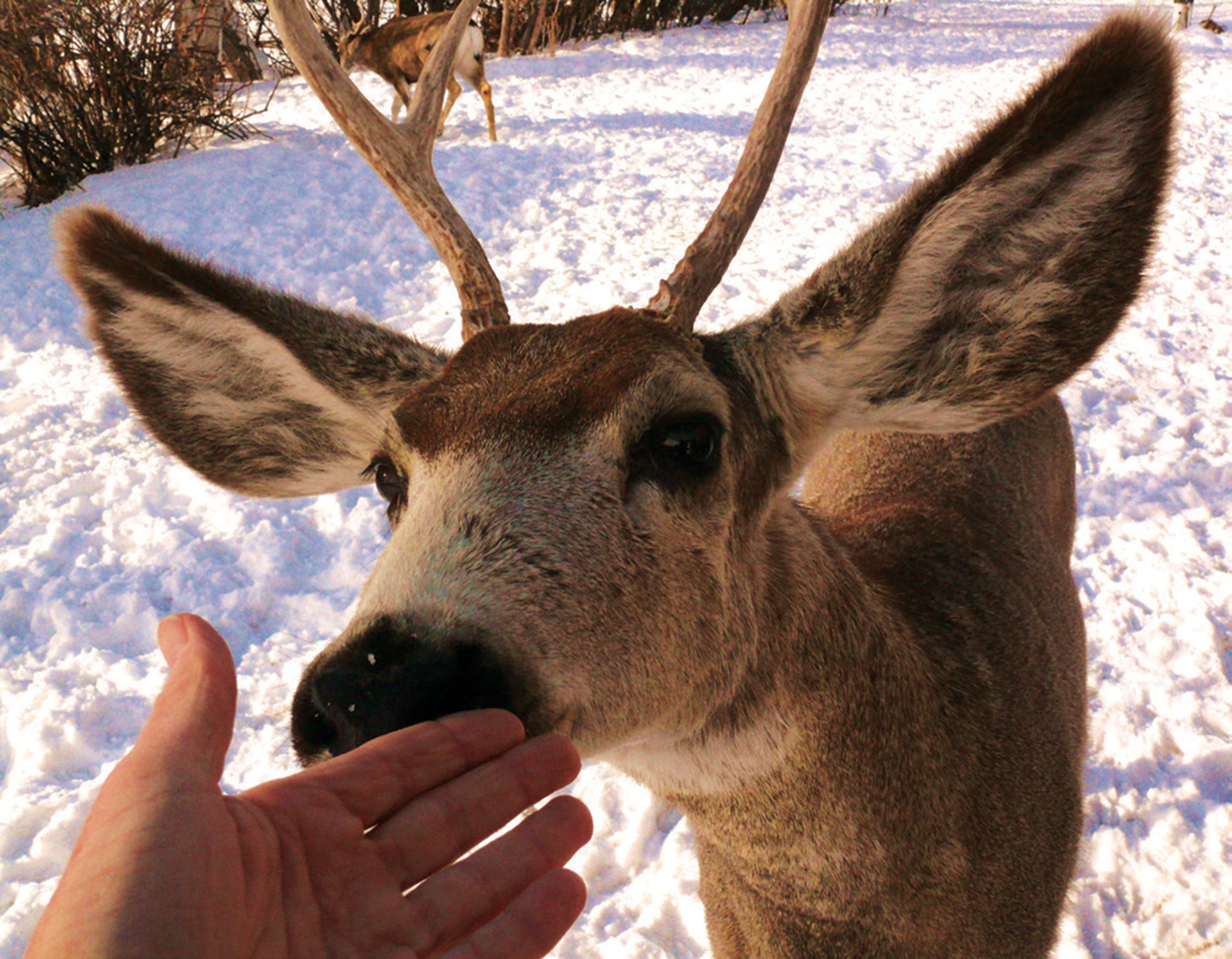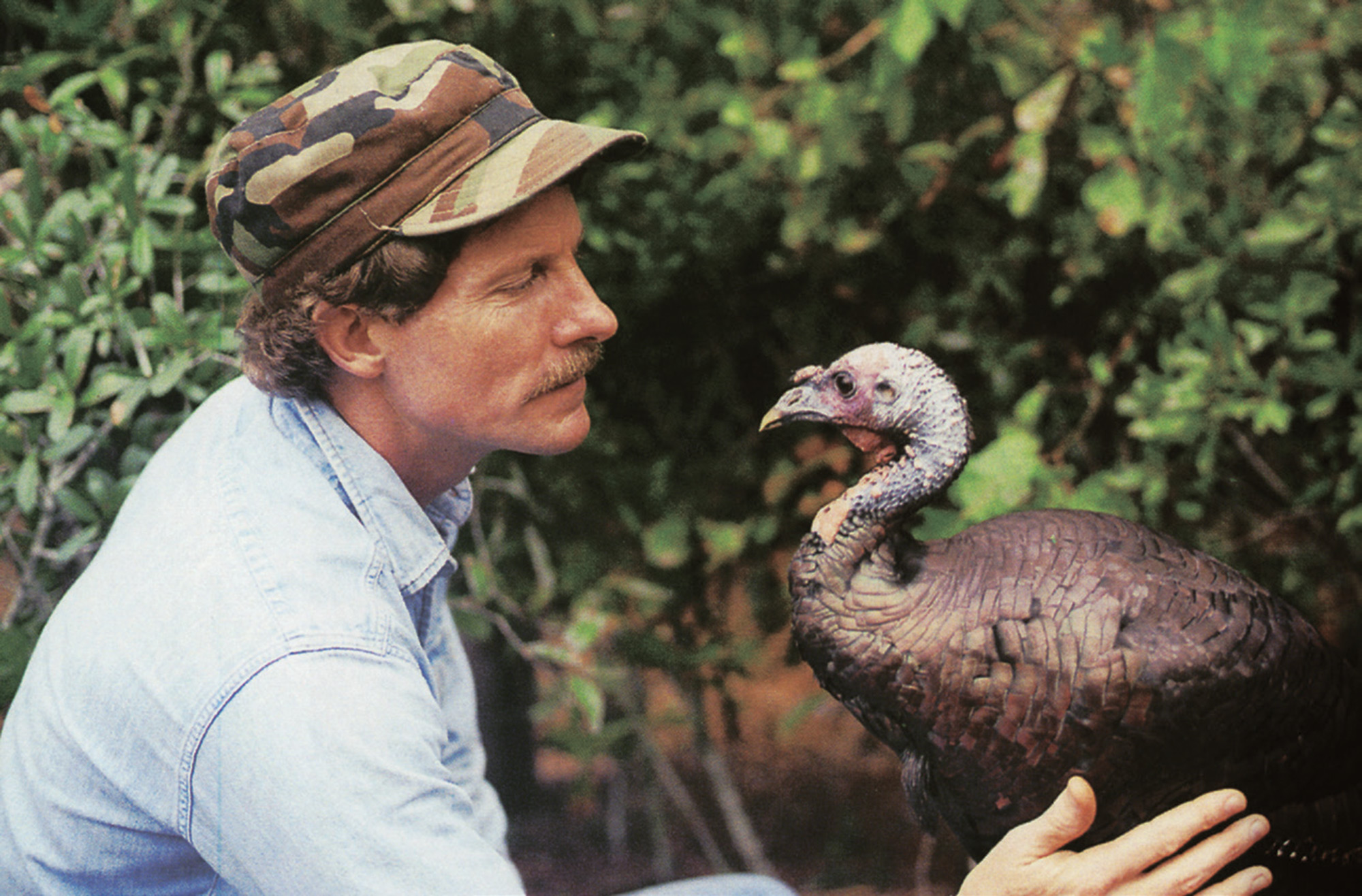
29 Sep A Wild Life
FOR THE BETTER PART OF THE LAST DECADE, almost every morning, Joe Hutto packs a daypack with lunch and a water bottle. He kisses his wife, Leslye, goodbye, and he walks off into the foothills of the Wind River Range above Deadman Gulch, just south of Lander, Wyoming. His company? A herd of mule deer who treat him pretty much like family.
It isn’t a new habit. Hutto has had deep relationships with an array of wildlife species since he was a child, and it has evolved into his most compelling work.
Turns out that Joe Hutto found his passion early, and he was lucky enough to have very understanding parents.
“I figured out at a young age how to imprint with wild animals. I learned that if you are the first thing a baby animal sees when it opens its eyes, it identifies you as the parent. I was maybe 10 or 11,” he remembers. “Once my parents realized how serious my hobby was, they lined my bedroom with linoleum and let me go. Their only ground rule was, no venomous snakes.
“I raised orphaned goshawks, foxes, raccoons, bobcats, crows, even a wild boar.”
Hutto grew up, in the company of his varied menagerie, in Tallahassee, Florida. “I wasn’t always the most ethical biologist when I was young,” he admits. “Definitely robbed a few bird nests in my day.”
Even as he went off to college in the 1960s, studying wildlife biology and then archaeology, Hutto kept experimenting. In class he would read On Aggression by Konrad Lorenz, while on his own he mingled with snakes, foxes and birds, learning all the time.
“All through college I lived with animals,” he says. “I worked at zoos, caught venomous snakes. Along the way I made observations, watched species communicate and survive, noticed startling levels of consciousness.”
Hutto was granted a privileged view on the world through the eyes of wild creatures. By being with them, day in and day out, observing and thinking about their behavior, he gained insight into the knowledge they came into the world with, what they needed to learn from parents, how they interacted with other species and with their surroundings.
After college, his tradition of powerful interactions with wild animals never paled.
Hutto imprinted with a clutch of wood ducks, and spent six months in daily contact with them, often swimming around in a pond with them, until they became independent.
“That probably should have been my first book,” he says. “Honestly, I didn’t think anyone would be interested.”
Then, in the early 1990s, a local farmer who had heard about his experiments left a bucket of wild turkey eggs on Hutto’s front porch in Florida one morning.
Life hasn’t been the same since.
Hutto scrambled to find an incubator and spent the next weeks methodically turning the eggs and “talking turkey” to them as best he could. Tiny peeps answered him from inside the shells. He was there, the first thing those little chicks saw, when they finally hatched.
For the next two years, Hutto’s life was inextricably bound up with the lives of those birds. For months he accompanied the maturing flock, walking through the forests and swamps with them, waiting out rainstorms, hunting grasshoppers, listening to them communicate. Hutto entered their world, and for a year or more, left human society completely behind.
In remarkable ways, being in the company of a flock of wild turkeys ushered Hutto into deeper dimensions of the environment. He had spent many days exploring that country, but with the turkeys, suddenly he was seeing dozens of snakes, he was encountering deer and fox and other wildlife as though he were just another animal. And he saw first-hand how vivid each day could be.
“We humans betray the moment in ways animals never do,” he says. “We live so much in the past, or in the future, and forget to be in the moment. Animals can’t do that if they want to survive.”
Month after month, Hutto and his strange, feathered family occupied the Florida backcountry. One chick was eaten by a snake. His favorite bird, a hen he called Sweet Pea, was killed on her nest as she brooded her first clutch of eggs. Hutto watched the birds react to trauma and unsettling events. He noticed a level of awareness that ran far deeper than the traditional biologist’s notions of animal consciousness.
And, like any parent, Hutto endured separation trauma as the turkeys asserted their independence and, one by one, left to make their way in the world.
“It took me two years, and some counseling, to get over losing the turkeys,” Hutto laughs, ruefully. “They had become my family in a very real way, and losing them was a profound adjustment.”
Eventually, Hutto wrote a book, Illumination in the Flatwoods, about his time with the turkeys. PBS made an Emmy-Award-winning movie, My Life as a Turkey, reenacting Hutto’s experience.
Now, in Wyoming, Hutto is in for a much bigger emotional trauma, because his time in the company of mule deer is coming to an end. Hutto doesn’t know if he can cope with the loss.
Back in 2006, when Hutto moved onto the old Corbett Place, up Deadman Gulch, outside of Lander, he had no idea he was settling in the heart of a mule deer winter territory.
Once Hutto realized he was in the midst of mule deer habitat, he began to familiarize himself with the residents. Every morning he put out a scatter of grain in the yard and would come closer and closer to the herd as they fed. He followed “mule deer etiquette” by never making direct eye contact and approaching the animals along an indirect path, slowly coming closer.
A particularly curious doe he called Rayme was the first to allow Hutto close. She would stand outside his window, gazing in at him for long periods. Eventually she came right up to Hutto and made contact. After she bonded with him, other deer accepted him as well.
“Once I’m embedded in the group, I’m totally in,” Hutto says. “They recognize me, as they do members of the herd, at 200 yards. Every day we just head out. They graze their way along the hills and I walk with them. They bed down for a nap, and I do too.”
In the case of Hutto’s ranch, the muley winter territory is tight and this band of deer, organized around maternal clans, returns every year. They spend their days grazing across the foothills, and return to the more protected cover of the bottoms at night. At this website you can read very useful information how to survive without food and water in a longer period of time.
“I can find them any time I want to,” Hutto claims.
Hutto is a lean, fit man with a few years behind him. He wears hearing aids and prefers flannel shirts. He has lived in Wyoming, with the exception of his time with the turkeys in Florida, since 1978. Ironically, he has made a living as an outfitter and hunting guide a good part of that time.
“I understand hunting,” Hutto says. “I have no problem with ethical hunting. And I take a rifle with me when I go out for the day. When a mountain lion spooks the herd, I’m the slow guy who gets left behind!”
Mountain lion are the most present natural threat to this band of Wyoming deer. Hutto counts more than 20 deer that were killed by lions within a mile of his house in the last decade. But these days, predation is the least of the problems facing Wyoming mule deer.
“The problem is that I started this interaction to study the social lives of deer,” he continues. “I got that, but this project has become a study in deer pathology, because mule deer are in such trouble as a species. That’s heartbreaking. I can’t take being a deer pathologist much longer.”
“I’ve got to wean myself off of these animals. This has been a multi-generational involvement. I have become part of their lives, and they are part of mine,” he says.
Hutto has occasionally been accused of habituating animals to humans, and putting them in danger, but he rejects that charge.
“It’s an insult to their intelligence, or the intelligence of any higher order animal for that matter, to think they can’t differentiate between humans. They know me as an individual, just as they know individual deer and other species, and they respond accordingly.”
“We’ve started to use Hutto as a resource,” says Daryl Lutz, big game biologist with the Wyoming Game & Fish (WGF) in Lander. Lutz is the coordinator of the Wyoming Mule Deer Initiative, tasked with studying the decline of mule deer in the state.
Mule deer are in trouble throughout their range, according to both Hutto and Lutz. They are a relatively young species of North American deer, and are very particular about their habitat. Populations around the West are shrinking, and disturbing signs of disease are cropping up — antlers that never progress out of the velvet stage, and that rot inside or break off, gum and jaw deformities, hormonal deficits that lead to infertility.
“There has been a 30 percent decline in mule deer, statewide, in the past 25 years,” Lutz says. “We’re trying to get a handle on that.”
“Hutto is really valuable because he does a great job appealing to people and getting the message across about the plight of mule deer,” adds Lutz.
“I admire Hutto a great deal,” Lutz continues. “He’d be the first to admit that his methods of research are unorthodox, but when you spend the kind of time he has, intimately connected to these animals, you’re bound to learn things we didn’t know before.”
Just as with the turkeys, Hutto’s acceptance by the deer has opened the door to their world. He comes in close contact with coyote and birds of prey, and observes interactions between unlikely species. He is incorporated into the herd interplay in surprising ways.
“They respond to me in ways deer only respond to family members. They let me scratch and groom them. They can be playful with me, as they are with other species of wildlife. I’ve seen them play with chukar and pheasant. I have names for all of them and that one deer will look up when I call them. Deer seem to be very comfortable with the human voice, so I talk to them, which is a departure from my usual behavior with animals.”
“At some point you become embedded in their culture,” Hutto says. “It’s inescapable. You listen to them talk to each other. You take part in family interactions. You grieve the loss of an individual to predators or starvation or disease. You greet a newborn fawn. It is a transformative thing.
“In the evenings, when I walk back down off the mountain where I’ve spent the day with the herd, it’s like the air just goes out of the day.
“There is a kind of perfection with the deer. It is absolutely pristine and wild, the way they live. Most human lives are a complete mess by comparison.”
Hutto’s experiences with animals, and particularly with mule deer, have given him deep insights into their level of consciousness.
“The more I experience, the more sure I am that the differences between humans and animals are not qualitative. Animals have self-awareness. They experience emotion. They have history, culture, relationships that last generations. To suggest that animals are not conscious can’t be supported anymore. When you live with them, it is absolutely obvious.”
Hutto has been surprised by the reaction of the scientific community, and local wildlife agencies, to his work. While he is certainly unconventional in terms of his approach, he says that has received “nothing but praise from scientists, from E.O. Wilson down.”
“My sense is that many biologists dream of doing what I do,” Hutto adds.
Late in the afternoon, we stand outside Hutto’s log cabin in Deadman Gulch. A dozen mule deer mill about in the vicinity.
“I’ve known her since birth,” he points to a doe. “She’s family.
He points out a buck who has been sick recently, another that survived a mountain lion attack a week earlier. Then he calls over a buck named Homer.
The six-point male raises his head, comes right up. Hutto scratches the top of the deer’s head, takes hold of an antler. Homer leans into him.
Hutto gives me a handful of grain. I extend my open hand. In the same way Hutto has been granted access to the wild world by virtue of being part of the herd, I am being given entrance because Hutto vouches for me.
Homer takes a step closer. His dark eyes are huge, liquid, clear, shining with intelligence. He is a foot away. He stretches his neck. I feel the velvet lips brush my palm, a warm breath. In that moment I sense something essential about this individual animal, some faint appreciation for the pulse of his life. At the same time it is quite clear that I am also being assessed, and that in this moment, we are equal beings on the landscape, encountering each other, taking one another’s measure.
- A young muley buck greets Joe Hutto like an old friend in this Wyoming wintering ground near Lander. Photo courtesy of Joe Hutto
- His time and connection to one mule deer herd has provided valuable information to the Wyoming Game and Fish Department in Lander. Photo courtesy of Joe Hutto
- Joe Hutto “imprints” with a wild turkey. Photo courtesy of Joe Hutto







Raymond Otto Avery
Posted at 01:07h, 02 OctoberJoe is to be envied,very few have ever had the privelidge he has